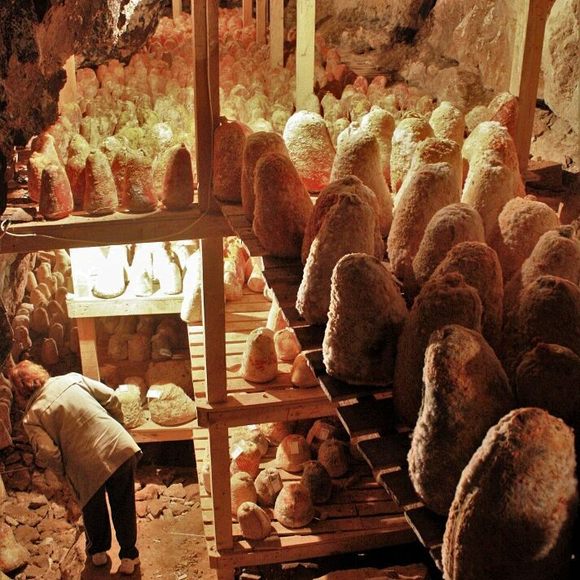Meats & Animal Products
Divle Obruk
The rare, cave-aged Turkish cheese is one of the last vestiges of a dying cheese-making tradition.
Few nomadic sheepherders remain on the semi-arid steppe of south-central Turkey, a part of the Anatolian plateau that the farmers call the “yellow pasture.” But in the village of Divle (now officially known as Üçharman), 300 shepherds and their 3,500 livestock (goats and red sheep) are the keepers of a quickly-fading beacon of culinary craftsmanship: the making of Divle Obruk, a rare local tulum, the Turkish name for cheese aged in a sheepskin or goatskin sack. Obruk means pothole, possibly a reference to the crevices in the cave where the tulum is aged.
Cheese production for Divle Obruk begins in April. Traditionally, milk from purebred Karaman sheep was used, but that breed has since dwindled in the region. These days, both goat and sheep’s milk is used. After the milk is warmed and coagulated with the addition of calf rennet, the resulting cheese is left to rest for several days, then soaked in water to reduce bitterness. It is then washed, pressed under rocks to remove moisture, slathered with salt, and eventually crumbled and packed by hand into clean bags made of sheepskin or goatskin. Some bags can hold as much as 50 pounds. Making the bags themselves takes time. The skins must be washed, salted, and left to air-dry in the harsh Anatolian sun for several days (sometimes up to a year), and they can be used only once.
This precious cheese is then transported to a cave just outside the village, where it descends more than 100 feet down in a single-seat elevator. It will be aged for a few months (usually May to September) in this damp, cool sanctum sanctorum where the temperature year-round is 39°F. The cave’s unique microclimate causes a particular mold to encase the cheese, giving it a distinctive flavor and aroma. As the rind forms, it first turns bluish, then white with mold (of the same strain as Roquefort cheese), and ultimately takes on a gnarled reddish tone through exposure to the cave’s bacteria. Once aging is complete, Divle Obruk is white or pale yellow in color when cut open. The cheese gets sharper as it ages, and has top notes ranging from grassy fields and hazelnut butter to caramelized garlic or even more musky animal tones.
The cave can store 70 tons of cheese per production cycle; today, however, producers typically fill it with only 13 to 14 tons. Unfortunately, the odds are against tulum-making in Divle: Masses of the original population have moved to more urban areas, reducing both demand and labor resources. Moreover, climate change and encroaching industrial farming is wreaking havoc on an already-parched terrain, further pushing populations (and livestock) away from the region.
Most Divle Obruk is consumed locally, eaten with thin slices of bread, or served with fruit or as an accompaniment to rakı, the Turkish aniseed liquor. Some of it is sent to large Turkish cities such as Istanbul and Ankara, where it is sold to individual customers or restaurants.
Where to Try It
-
Ferahfeza Karaköy Website
Kemankeş Karamustafa Paşa Mahallesi, Kemankeş Cd. No:31, Beyoğlu/İstanbul, TurkeyThis chic rooftop restaurant-with-a-view in Istanbul sometimes has Divle Obruk on the menu. Best to call and inquire before going.
Written By
 Rohini Chaki
Rohini Chaki
















